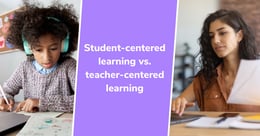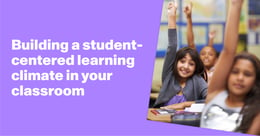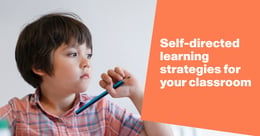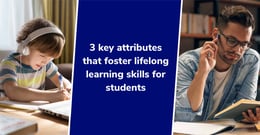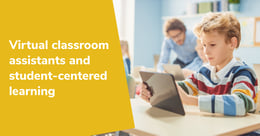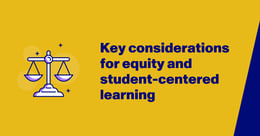
What teachers gain from student-centered learning
For adherents of student-centered learning, it may seem fairly self-apparent that students stand to benefit from having more agency over their education. What may be less obvious is that such initiatives can have a positive impact on teachers too.
As we consider the relative merits of student-centered learning vs. teacher-centered learning, it’s important to keep in mind that one party’s gain is not necessarily the other’s loss. Teachers’ objectives and students’ interests can be closely aligned.
In fact, student-centered learning can be quite empowering for educators. Read on to explore how teachers can truly gain a great deal from their students in a learner-centered environment.
An evolving understanding of teachers’ roles
It’s no secret that the past few years have been particularly challenging for educators. In the face of the pandemic, promoting teacher wellness has become a top priority for schools and districts throughout the country.
In this context, it’s worth noting that the pursuit of student-centered learning initiatives may cause educators to rethink how they view their work and themselves. According to a study on teachers’ roles in student-centered STEM classrooms, this presents both challenges and opportunities.
The report explored how STEM educators responded to the process of implementing a more student-centered approach in their teaching. Those who felt their professional identities were well aligned with the new methods found the experience a gratifying way to pursue their highest aspirations as an educator.
That said, teachers who saw themselves as “deliverers of STEM content” faced a more challenging transition. During the process, they had to reevaluate how they thought about their identities and their careers. While it was challenging, many became champions of this transformation.
It’s important to know that some teachers, based on their self-perceptions, immediately gravitate toward student-centered learning. If that’s you, great! If it sounds more challenging to you, remaining flexible and open-minded could help you work through potential obstacles to reap lasting benefits.
Benefiting from students’ self-directed choices
As you begin to implement more student-centered learning strategies in your classroom, you might try out some self-directed learning activities. Such exercises allow learners to practice more choice over what they study, the ways in which they learn, and how they share their discoveries. Teachers can gain a greater understanding of what learners need by paying attention to these choices, and heightened student engagement means smooth-running classrooms for educators.
In student-directed learning activities, students might select for themselves:
- Which texts they study.
- What learning approaches they employ to gather knowledge and information.
- The materials they use for sharing their findings, analyses, or reflections.
A recent article from Edutopia focused on why student choice matters for all grade levels. The story highlighted that when educators create new opportunities for learners to choose things like what classroom jobs are needed, where to work, what norms to set, what to read, and how to handle unstructured time, the students buy in. Rather than feeling like they have to comply with a narrow set of prescribed options, an open field can help students connect to their environment.
With the elevated level of engagement that can come from empowering learners to make self-directed choices, teachers may see that they spend less time managing behavior and more time in meaningful, constructive exchanges with their students.
Edtech insights gleaned from learners
Using technology to support student-centered learning can go a long way toward facilitating the kind of personalization that allows students to thrive. Technology can help students get individualized support and provide them with a wide variety of opportunities for making self-directed choices.
Additionally, students may have creative ideas of their own about how to integrate technology into classroom instruction and asynchronous learning—a perspective that teachers could definitely benefit from.
Create engaging lessons with an eye toward tech use
In an Edutopia article about popular frameworks for using technology in the classroom, a model known as PICRAT—an acronym for “passively, interactively, or creatively” and “replace, amplify, or transform”—stands out as a technique for understanding how students incorporate high-tech tools into their learning.
With PICRAT, teachers are encouraged to gauge both how they’re employing technology within a lesson and how students are using it. Does the student use the tool passively, interactively, or creatively? Giving students the opportunity to select the tech tools of their choice can help encourage creative usage.
As teachers strive for more engaging lessons that facilitate creative edtech usage, they stand to gain from a classroom environment where originality, innovation, and discovery lead the way. These values can help cultivate a space where intrinsic motivation rules, meaning educators may have to do less coaxing to get their students to engage with key concepts.
Derive insights from data provided by student-centered edtech
Beyond these opportunities, many student-centered edtech tools offer built-in teacher dashboards that can prove beneficial for educators. Such technology can help teachers gather more insights about student behavior that can then be used to identify and bridge learning gaps.
When learners have the power to use technology to ask their own questions and explore their own curiosities, teachers with access to these platforms can learn even more about what their students need, helping these educators further refine their instructional practices.
Opportunities to grow through student-centered feedback loops
In a student-centered learning environment, not only do students’ choices matter—their voices do too.
An Edutopia article on the value of teacher-student feedback loops encouraged educators to reimagine feedback as a two-way exchange between learners and teachers. Just as students need feedback to grow, teachers benefit when they hear directly from their students.
Reciprocal feedback presents a twofold advantage:
- Teachers and students build rapport.
- Educators gain insight into what materials and opportunities will best support their students.
With this kind of information coming straight from learners, teachers have a leg up in their planning and a clear window into what students think will be most effective for their own learning.
Listening and learning: Teachers and students are in this together
When it comes to assessing the relative benefits of student-centered learning vs. teacher-centered learning, it’s clear that what students and teachers actually need are often complementary.
Though it can be challenging at first for some educators to shift into a student-centered mode, remaining open to the benefits they’ll gain from the approach can make all the difference. Implementing student-centered strategies can help teachers drive student engagement, improve classroom functioning, and create effective and engaging learning opportunities.
Want to learn more about the ins and outs of student-centered learning? Take a look at our K-12 guide to student-centered learning for useful insights and info.

